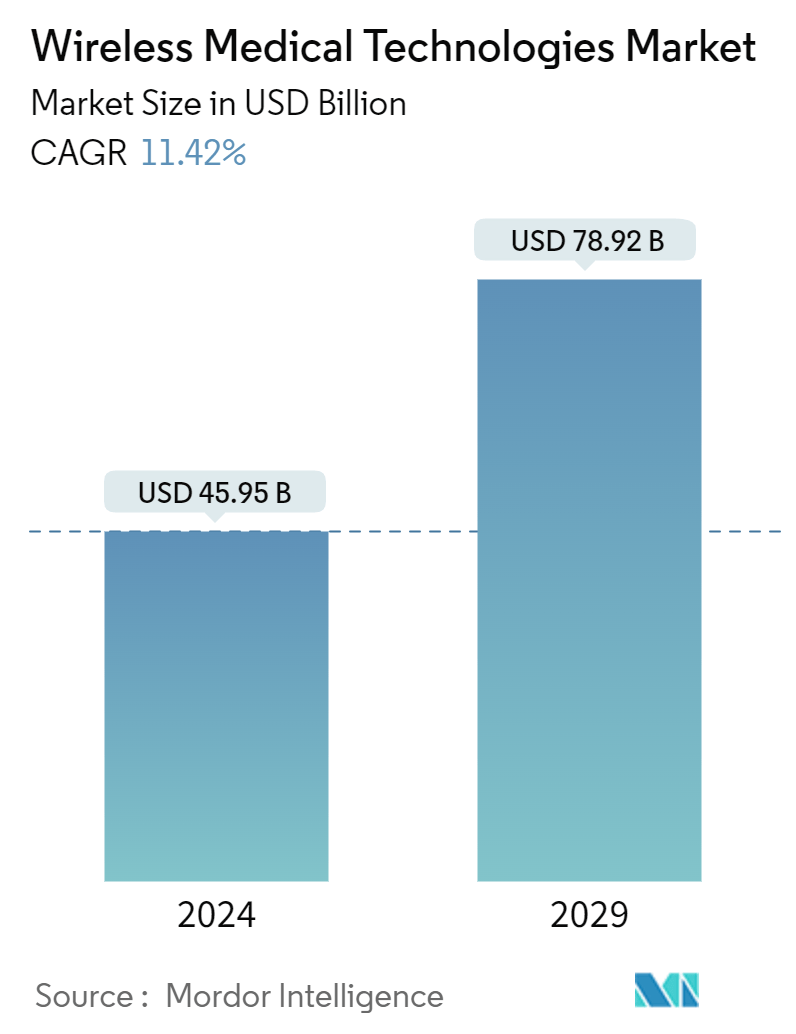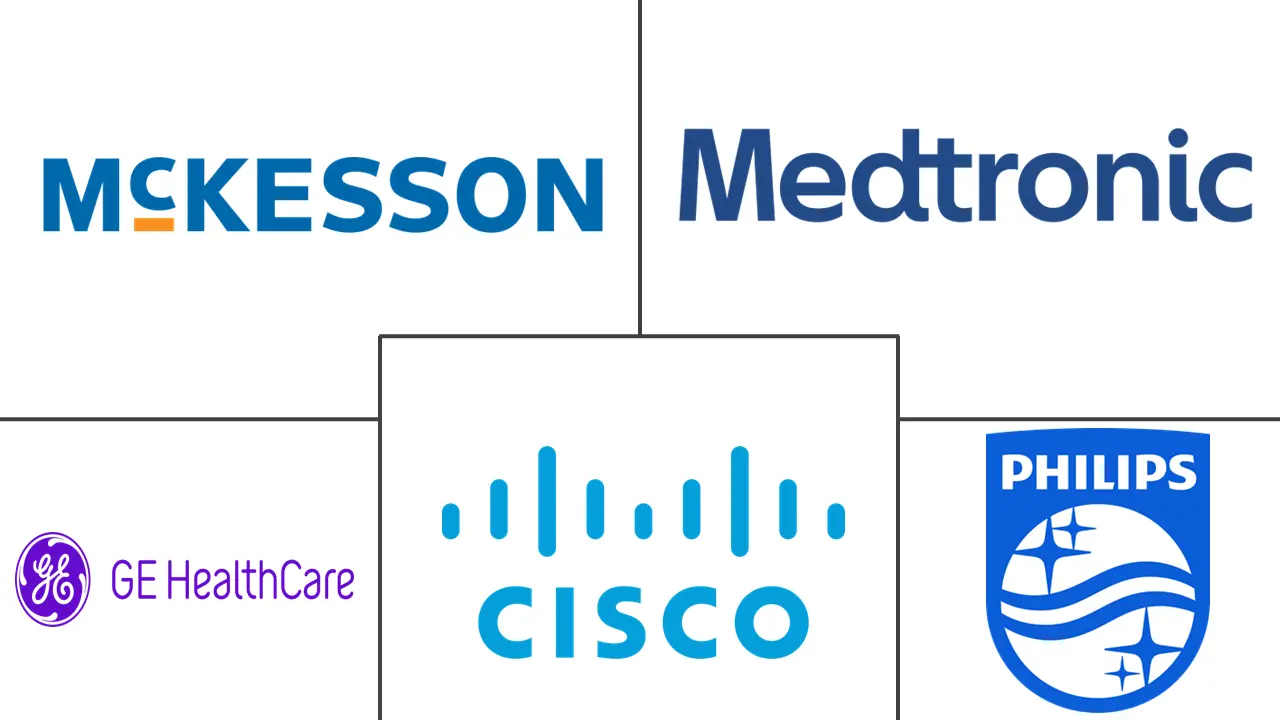Market Size of Wireless Medical Technologies Industry

| Study Period | 2019 - 2029 |
| Market Size (2024) | USD 45.95 Billion |
| Market Size (2029) | USD 78.92 Billion |
| CAGR (2024 - 2029) | 11.42 % |
| Fastest Growing Market | Asia-Pacific |
| Largest Market | North America |
| Market Concentration | Medium |
Major Players
*Disclaimer: Major Players sorted in no particular order |
Wireless Medical Technologies Market Analysis
The Wireless Medical Technologies Market size is estimated at USD 45.95 billion in 2024, and is expected to reach USD 78.92 billion by 2029, growing at a CAGR of 11.42% during the forecast period (2024-2029).
The major factors driving the growth of the market studied are increasing demand for digitalization of healthcare and rising technological advancements in wireless medical technologies.
Digitalization of healthcare is expected to increase the adoption of wireless medical technologies, which may drive the growth of the market studied over the forecast period. For instance, in February 2022, the Department of Health and Human Services, via the Health Resources and Services Administration, awarded USD 55 million to 29 HRSA-funded health centers to increase healthcare access and quality for underserved inhabitants through virtual care such as telehealth, digital patient tools, remote patient monitoring, and health information technology platforms. According to the Canadian Digital Health Survey of April 2024, the online survey conducted in November 2022 with 12,445 Canadians across all provinces and territories showed that 94% of Canadians were interested in accessing digital health services. Hence, with the digitalization of healthcare, the adoption of wireless medical technologies is expected to increase for better patient medical data transfer and patient monitoring.
In December 2023, AT&T reported joining smart healthcare, which was marked by its commitment to expanding high-speed internet and collaborating with the healthcare industry. Incorporating 5G into healthcare infrastructures markedly improves the speed and reliability with which these large imaging files are transmitted.
Furthermore, in October 2022, Xenter reported the launch of XenFI, the first product in the company's wireless "Technology in Medicine" ecosystem, to improve the adoption of new technology in the healthcare industry. The newly launched product comprises XMD (a HIPAA-compliant, global healthcare cloud) and XenFI-Hub, Xenter's wireless communications device designed for various healthcare settings. Moreover, in March 2023, Amala Hospital launched an innovative smart ward with wearable wireless technology. The smart ward is equipped with advanced technology that offers continuous patient monitoring. The ward aims at improving patient outcomes and reducing the risk of medical errors.
Thus, the increasing digitalization of healthcare and rising technological advancements are expected to drive the growth of the market studied over the forecast period. However, cyber security and privacy issues are expected to hinder the growth of the wireless medical technologies market during the forecast period.
Wireless Medical Technologies Industry Segmentation
Wireless medical technologies integrated into traditional medicine, such as diagnosis, monitoring, and treatment of illness, can help individuals improve their personal health and well-being.
The wireless medical technology market is segmented by technology, application, component type, end user, and geography. By technology, the market is segmented into wireless wide area network (WWAN), wireless personal area network (WPAN), worldwide interoperability for microwave access (WiMAX), and wireless body area network (WBAN). By application, the market is segmented into patient-specific and provider-specific. By component, the market is segmented into software, hardware, and services. By end user, the market is segmented into providers, payers, and patients. By geography, the market is segmented into Geography (North America, Europe, Asia-Pacific, Middle East and Africa, and South America). The report offers market size and forecast in terms of value (USD) for the above segments.
| By Technology | |
| Wireless Wide Area Network (WWAN) | |
| Wireless Personal Area Network (WPAN) | |
| Worldwide Interoperability for Microwave Access (WiMAX) | |
| Wireless Body Area Networks (WBANs) |
| By Application | |
| Patient-specific | |
| Provider-specific |
| By Component Type | |
| Software | |
| Hardware | |
| Services |
| By End-user | |
| Provider | |
| Payers | |
| Patients |
| Geography | ||||||||
| ||||||||
| ||||||||
| ||||||||
| ||||||||
|
Wireless Medical Technologies Market Size Summary
The wireless medical technologies market is poised for significant growth, driven by the increasing digitalization of healthcare and advancements in wireless technologies. The demand for digital health solutions, such as telehealth and remote patient monitoring, is on the rise, facilitating better patient data transfer and monitoring. Initiatives like the Health Resources and Services Administration's funding for virtual care and the Canadian Digital Health Survey's findings underscore the growing interest in digital health services. Companies are actively developing and launching innovative products, such as Xenter's XenFI and Amala Hospital's smart ward, to enhance healthcare delivery. However, challenges related to cybersecurity and privacy concerns may impede market expansion.
The adoption of wireless body area networks (WBANs) is expected to contribute significantly to market growth, particularly in monitoring chronic diseases. These networks enable real-time, remote access to patient data, improving healthcare outcomes. The increasing prevalence of chronic conditions, such as heart disease and diabetes, further fuels the demand for WBAN technologies. North America is anticipated to hold a substantial market share, supported by the region's embrace of digital health and wireless advancements. Key players like Koninklijke Philips NV, GE Healthcare, and Medtronic PLC are focusing on innovative product launches to maintain a competitive edge in this dynamic market landscape.
Wireless Medical Technologies Market Size - Table of Contents
-
1. MARKET DYNAMICS
-
1.1 Market Overview
-
1.2 Market Drivers
-
1.2.1 Increasing Demand for Digitalization of Healthcare
-
1.2.2 Rising Technological Advancements in Wireless Medical Technologies.
-
-
1.3 Market Restraints
-
1.3.1 Cyber Security and Privacy Issues
-
-
1.4 Porter's Five Forces Analysis
-
1.4.1 Threat of New Entrants
-
1.4.2 Bargaining Power of Buyers/Consumers
-
1.4.3 Bargaining Power of Suppliers
-
1.4.4 Threat of Substitute Products
-
1.4.5 Intensity of Competitive Rivalry
-
-
-
2. MARKET SEGMENTATION (Market Size by Value – USD)
-
2.1 By Technology
-
2.1.1 Wireless Wide Area Network (WWAN)
-
2.1.2 Wireless Personal Area Network (WPAN)
-
2.1.3 Worldwide Interoperability for Microwave Access (WiMAX)
-
2.1.4 Wireless Body Area Networks (WBANs)
-
-
2.2 By Application
-
2.2.1 Patient-specific
-
2.2.2 Provider-specific
-
-
2.3 By Component Type
-
2.3.1 Software
-
2.3.2 Hardware
-
2.3.3 Services
-
-
2.4 By End-user
-
2.4.1 Provider
-
2.4.2 Payers
-
2.4.3 Patients
-
-
2.5 Geography
-
2.5.1 North America
-
2.5.1.1 United States
-
2.5.1.2 Canada
-
2.5.1.3 Mexico
-
-
2.5.2 Europe
-
2.5.2.1 Germany
-
2.5.2.2 United Kingdom
-
2.5.2.3 France
-
2.5.2.4 Italy
-
2.5.2.5 Spain
-
2.5.2.6 Rest of Europe
-
-
2.5.3 Asia-Pacific
-
2.5.3.1 China
-
2.5.3.2 Japan
-
2.5.3.3 India
-
2.5.3.4 Australia
-
2.5.3.5 South Korea
-
2.5.3.6 Rest of Asia-Pacific
-
-
2.5.4 Middle East and Africa
-
2.5.4.1 GCC
-
2.5.4.2 South Africa
-
2.5.4.3 Rest of Middle East and Africa
-
-
2.5.5 South America
-
2.5.5.1 Brazil
-
2.5.5.2 Argentina
-
2.5.5.3 Rest of South America
-
-
-
Wireless Medical Technologies Market Size FAQs
How big is the Wireless Medical Technologies Market?
The Wireless Medical Technologies Market size is expected to reach USD 51.20 billion in 2025 and grow at a CAGR of 11.42% to reach USD 87.92 billion by 2030.
What is the current Wireless Medical Technologies Market size?
In 2025, the Wireless Medical Technologies Market size is expected to reach USD 51.20 billion.

